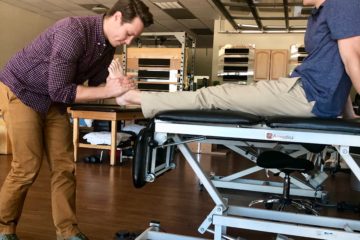Squatting Do’s and Dont’s
Posted on May 31, 2013 by Kasey Aiken
We get asked quite frequently “Is it bad to do squats for a work out?” “How can I protect my spine during work outs?” “It hurts my low back when I’m squatting, do I need to quit?” After observing the squat position of many of our patients, I would prefer to say they should not be squatting until we fix x, y, and z. At STAR, we follow the practices of an institute named Postural Restoration Institute or PRI. PRI has many helpful guidelines, tests, and measures for us as practitioners to follow and help determine whether we feel it’s safe for a patient to return to a work out program involving squatting.
The consistent problem we see in a squat with our patients is a moderate anterior pelvic tilt with increased use of the lower back paraspinal muscles, and knees falling forward over the toes. This is usually observed in a patient squatting without weight. Seeing this with no weight, we can only guess how poor the form may be with 50 pounds+ of weight on the shoulders. The patient is essentially performing a squat without activating their gluteal muscles and “core” muscles instead using all back and quad muscles. Performing a squat with using primarily the back and quad muscles can cause a number of orthopedic problems such as: herniated discs, increased break down of knee cartilage, lower back muscle strain, and hip impingement problems to name a few. The scarier part is that half of these patients are in an athletic program at school or in a work out program with supervision over their exercises.
Without having a full postural restoration evaluation, exact instructions may vary within individuals. The following listed below are just guidelines and a small checklist. It would be ideal to squat while looking in a mirror to be able to look at form from the side and head on or have someone else watch your positioning.
-
Before beginning a squat, proper shoe wear is a must. You should be able to make contact with your R inner arch without having to move the foot excessively.
- Feet should be about shoulder width apart and weight should be on your heels throughout the squat.
-
The position of the pelvis and the ribcage are two of the more important structures before beginning a squat.
-
A slight posterior pelvic tilt is desirable along with the ribcage slightly depressed in order to obtain a ZOA (PRI’s term: zone of apposition; meaning outer abdominal control through the internal obliques/transverse abdominis). This should be maintained throughout the squat and can be further explained in detail with a PRI assessment.
-
The chest should not be facing the ground. It should be positioned forward and open with the shoulder blades pulled down and back activating lower traps. The lower back should never be arched.
-
As you begin to squat, you should feel activation of the gluteal, quad, and hamstring muscles as well as the abdominals stabilizing the pelvis.
-
Never hold your breath during a squat; there are further breathing recommendations for each individual depending on strength as well as goals with squatting such as power or endurance. These assessments would be made following a postural restoration evaluation.

0 Comments